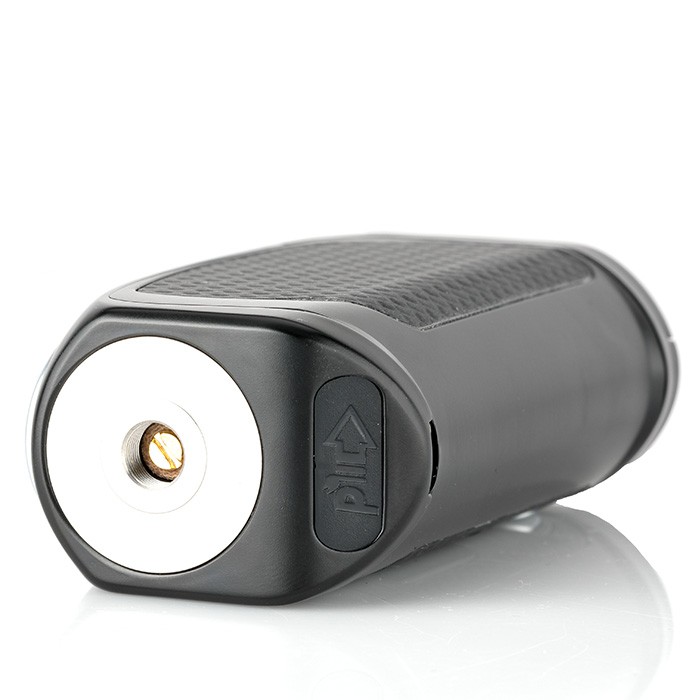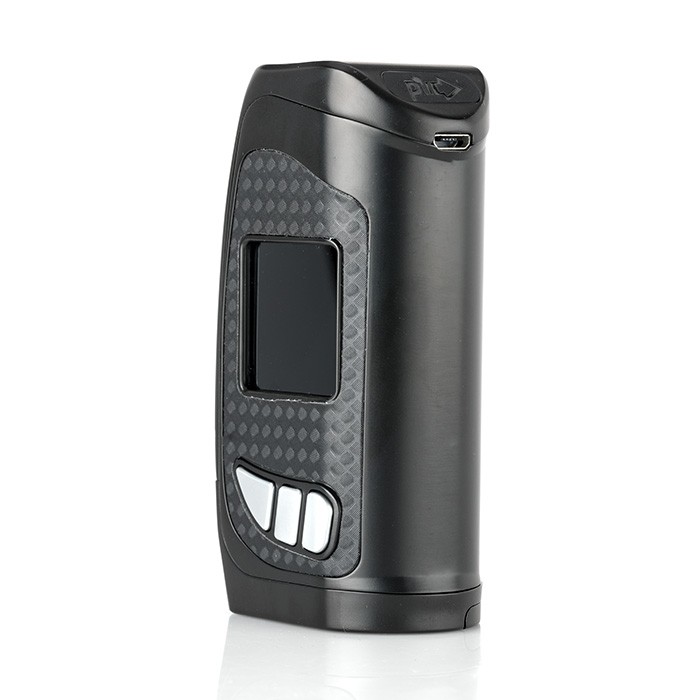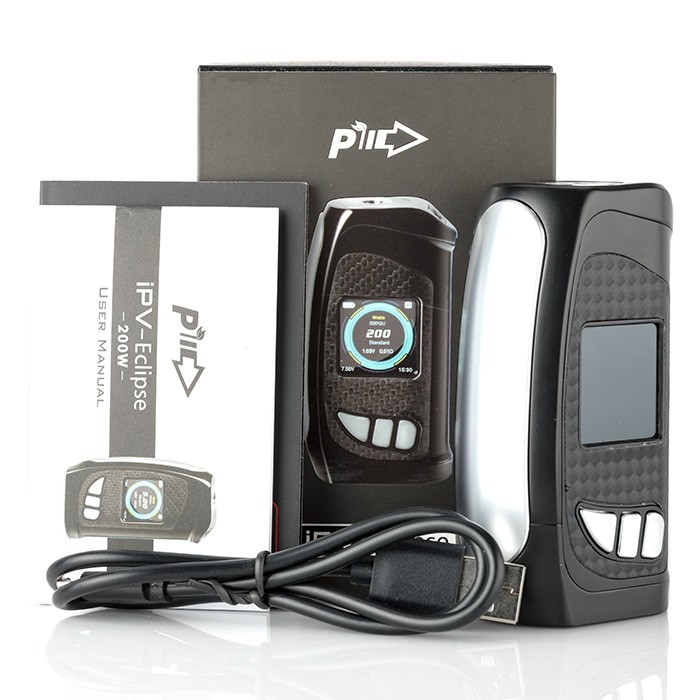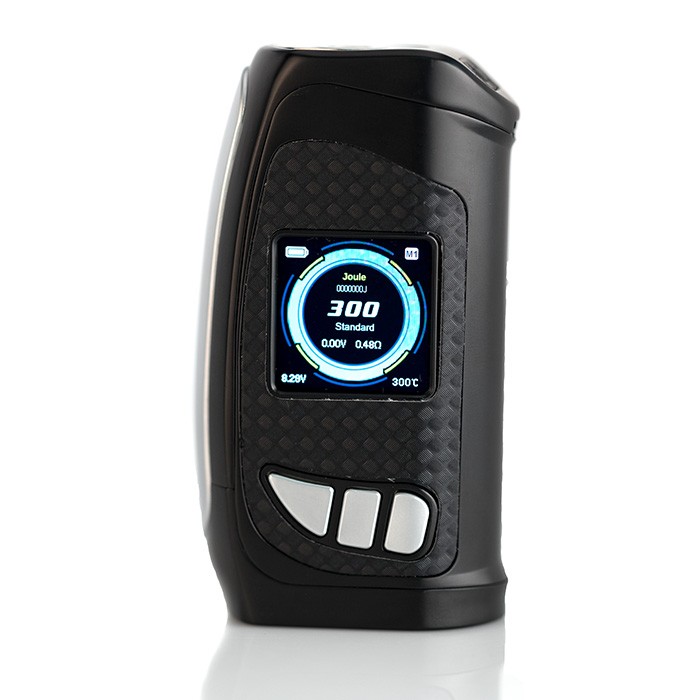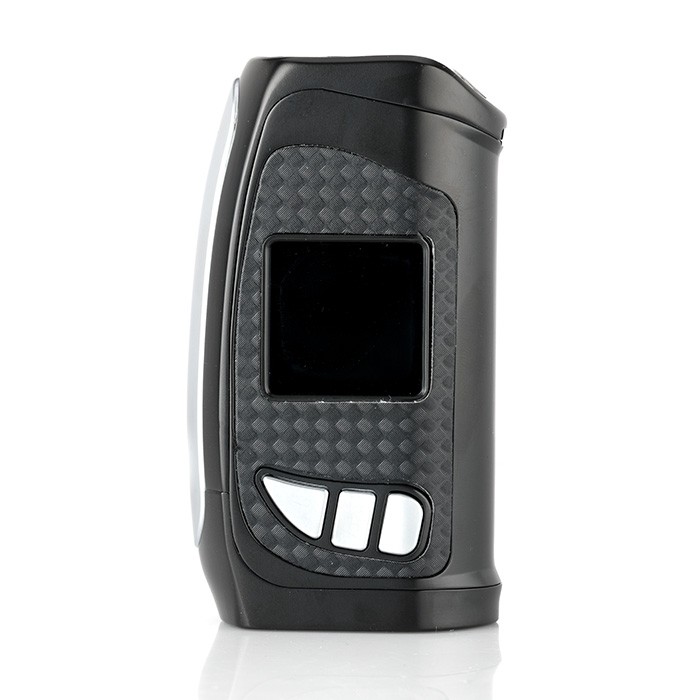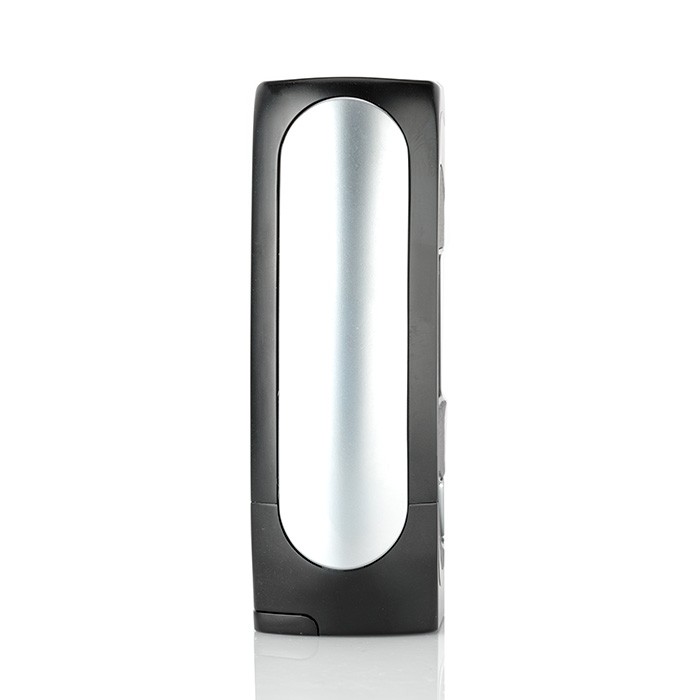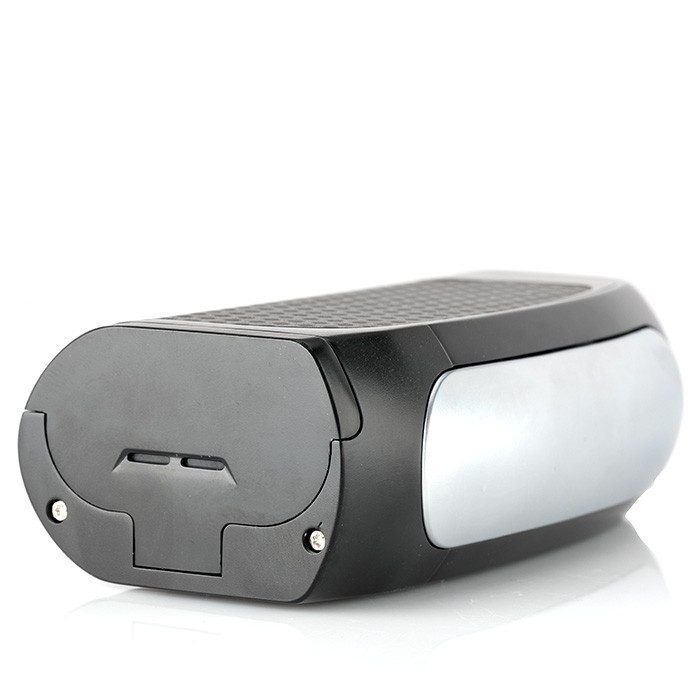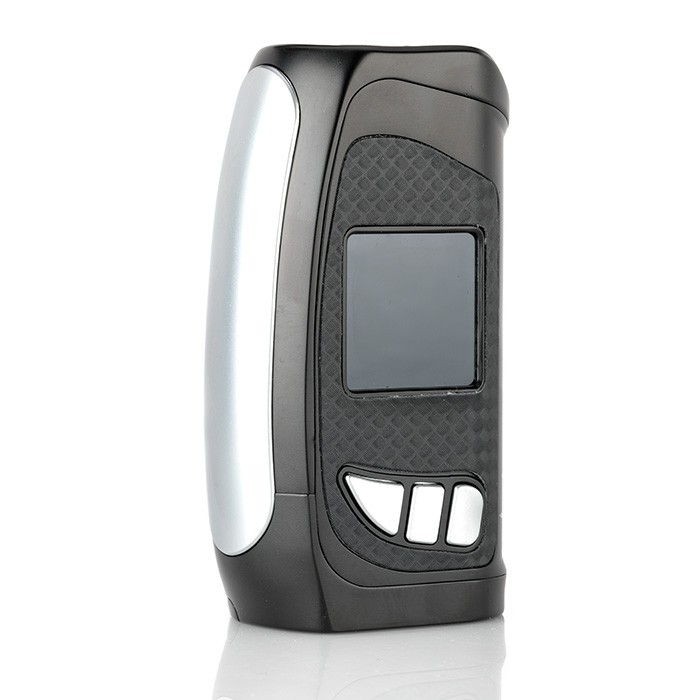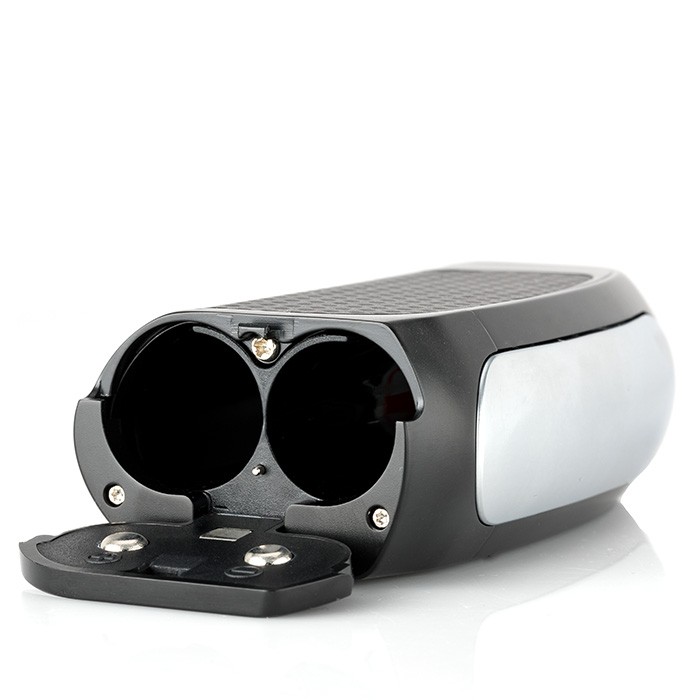Table of Contents [show]
The Pioneer4You IPV Eclipse 200W Box Mod is available now at here at – Element Vape.
Not since my last college relationship have I used the term “roller coaster of emotions.” While that may seem like an odd way to begin a vape mod review, that’s exactly how I felt using the Pioneer4You IPV Eclipse. Because, I don’t think I’ve ever used a device that brought me so many elated highs, and so many confusing lows.
Let’s take a deeper look what could be the most polarizing device in my collection.
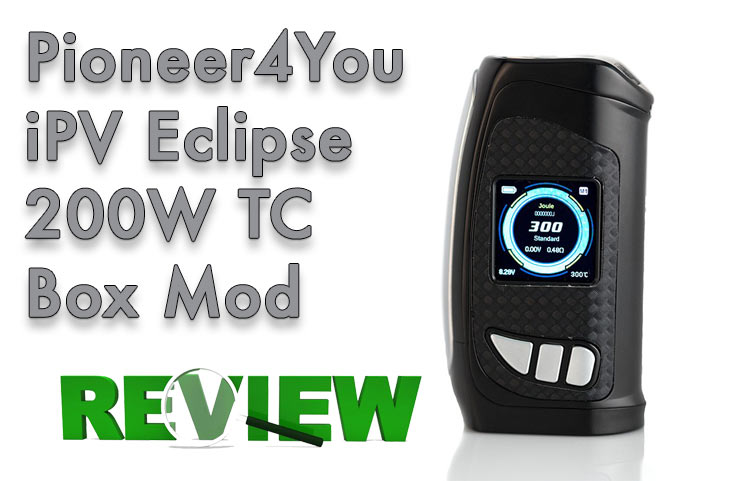
Initial impressions of the IPV Eclipse Mod
Let’s start off with the obvious: the IPV Eclipse doesn’t look like any other mod out there. This extremely attractive 200-watt box mod looks as if it was molded out of someone’s actual grip, with a curvaceous black frame and perfectly positioned fire bar. From the moment I removed it from the standard packaging, it immediately felt right in my hands.
The mod color schemes are simple, but bold. Each version contains the same dark grey/black matte zinc alloy frame, adorned with one of a handful of bright colors. My test model had a highly contrasting lime green scheme that – at first – seemed a little gaudy. But once the vibrant full color TFT display was active and customized, it went together nicely
.
Oh yeah, that screen. That glorious, flawless, stunning full-color screen. My goodness, does this thing shine. We’ve seen similar displays on the SX Mini G-Class, and the recently reviewed GTRS VBOY, and all were fantastic. But I feel like the IPV Eclipse display might be a touch sharper, brighter and more beautiful.
As we noted on those other devices, the YiHI SX software has been a pleasure to use, and the lush, colorful screen only makes it easier to use here. Unlike so many obtuse menu trees and overcomplicated systems, the software lays everything out in a logical, easily navigable manner.
Removing the IPV Eclipse from its simple foam encasement reveals a device that is hefty, but not unwieldy, and which feels amazing in either hand. To the naked eye, it simply seems like a mod with a curved frame. Once you hold it, it will make you wonder why so many box mods still resemble … well … boxes.
Whether this ergonomic win was the result of serendipitous luck, or extensive design research remains to be seen, but Pioneer4You absolutely nailed this design, and I hope it becomes the baseline for even more ergonomic mods to come.
The rest of the IPV Eclipse’s packaging is fairly spartan, as my test model didn’t even come with a USB cable. To be honest, I’m happy for that – does ANYONE need another random, unmarked, non-proprietary cable cluttering their drawers. I know I don’t.
Operating the IPV Eclipse Mod
Operating the IPV Eclipse was fine on a tactile level; the fire bar is excellent, with a firm, shallow throw that won’t go off in your pocket, unless you’re rocking seriously tight jeans. Likewise, the up/down/select action buttons all are similarly firm and taut. Yet, in the mod’s first design flaw, the left/down button is actually positioned higher on the face of the device, creating a little confusion when operating with one hand.
Plus, the same left button is also oddly shaped as part of a strange pattern on the front of the mod. The longer button comes to a point, which doesn’t bother me on a visual level, but the narrow end of the button is near useless when pressed, leading to more than a few failed interactions with the mod.
Once you get the hang of it, it’s not a problem, but on a device so geared toward accessibility, the fashion-over-function design stood out for all the wrong reasons.
Going deeper, the SX420 software is a slightly different version than we’ve used on other YiHi-powered devices. Yet, it featured a glaring issue we also experienced on the GTRS VBOY mod – erratic, jumpy ohms readings. Now, the IPV Eclipse didn’t have NEARLY the issues with inaccurate coil readings as the VBOY, but I still noticed multiple prebuilt and rebuildable atomizers jumping constantly after firing.
It should be noted that these jumps weren’t as drastic as they were on the VBOY, but all the same, on a device that touts precision, it was difficult to feel comfortable with varying ohms readings.
The rest of the menu system IS precise, however, and navigating these simplified menus and options was an absolute breeze. Experienced vapers will find all of the myriad options they’ve come to expect from modern chipsets, while newcomers will feel at ease with the sheer simplicity of a legible menu system, broadening the appeal of the IPV Eclipse.
The SXI-Q software is equally intuitive, though not nearly as deep as the platform it emulates, Escribe for DNA chipsets. But it does its job well, with custom curve settings and even wallpaper modification possible through the app. That said, I’m not sure there’s much the software can do that isn’t already possible on the device itself, and I found myself using it less and less as my testing progressed.
For even more personalized control over your vape, the IPV Eclipse also has SXi-Q-S1 mode, which gives users a software-based means to precisely dictate temperature increases at half-second intervals over a 20-second fire time.
Finally, the IPV Eclipse features a laundry list of modes and options, including all standard TC settings, TCR customization, firmware-specific SX Pure mode, variable power/draw settings, and a wealth of protective measures. It’s a truly complete package for power users of all types.
IPV Eclipse Photo Tour
Vaping the IPV Eclipse Mod
As mentioned both earlier in this review, and in the GTRS VBOY review, the odd ohms readings were a major concern when vaping. While the IPV Eclipse wasn’t nearly as erratic as the VBOY, it was still difficult to gauge accuracy and reliability when seeing a prebuilt SMOK Baby Beast coil read anywhere between 0.1 and 0.45 ohms within minutes.
Using rebuildable coils made things a little dicier, with a fresh set of Kanthal claptons jumping more than expected, even when firmly secured in the Anarchist Riot RDA. I saw similar results with coils in my iJOY Captain RDTA, the SMOK Cloud Beast with RBA deck and the GeekVape Ammit. Some were jumpier than others. None offered an inherently “bad” vape, but none were steady either.
To its credit, the Eclipse seemed to “right” itself better than the VBOY ever did, meaning my vape experience was much more consistent here than with similar devices.
At the risk of redundancy, I’ll restate the same claim for the IPV Eclipse as I did for the VBOY – I have no doubt this issue is directly related to a firmware hiccup, and can be easily rectified in seconds, provided YiHi makes the update available. That said, I also have yet to see anyone on Reddit or the vape forums mentioning this problem in regards to these devices, so it might not yet have manifested as an escalating problem.
(But really, what are the odds that Spinfuel received TWO YiHi chip devices with the same concerns, in the same week? It can’t be my imagination, however critical I may be.)
What isn’t debatable is random misfiring and pulsing draws in TC mode. Using a custom TCR setting to vape a pair of SS316 coils, I used the onboard software to craft a conservative 475-degree vape, and instead received an inconsistent mess of voltage spikes, atomizer warnings and misfires.
In between these missteps were some genuinely enjoyable draws, full of smooth power and flavorful vapor. But it was difficult to enjoy them when the fire bar only worked 70% of the time in this mode.
In power/wattage mode, my experience was better. I ignored the jumpy ohms and focused on the baseline performance of the mod. To that end, the IPV Eclipse was a much stronger device. Using a standard Big Baby Beast tank and a fresh V8 coil, I (mostly) enjoyed pulse-free, smooth vaping all the way to the coil’s 110-watt limit.
Pushing the device a little more, I managed to get my own 0.15-ohm coil (on the afore-mentioned Riot RDA) up to 170 watts before things got a little warm for my liking. The Eclipse managed to stay cool and steady up until that level, and I am comfortable in saying that its 200-watt limit is accurate.
But I don’t recommend vaping the Eclipse at that level for very long, unless you regularly travel with a slew of extra batteries. The Eclipse’s battery life is well-below-par for mods in this category – even the kindred VBOY and G-Class devices. I eked out 4-5 hours at most, with minimal menu navigation or variances in wattage and temperature. Disappointing, to say the least.
The Wrap Up and Score
This hurts to write, but I can’t recommend the IPV Eclipse until YiHi comes up with the right firmware upgrade. Which is an absolute shame, because in terms of design, comfort, navigation and affordability, the Eclipse is an absolute winner for any type of vaper. It’s a pleasure to hold, operate and fire, and I stand behind my desire for a firmware fix to the mod’s primary problem.
But if that was the only problem, it might be forgivable. However, the strange TC performance, random, incongruent warnings and overall inconsistency make the IPV Eclipse a “wait and see” option, when it could have been a “must-buy.” Let’s hope these bugs get worked out quickly, because every high-wattage vaper should have the chance to vape something this comfortable and intuitive.
One last thing, it is not unheard of to go ahead and purchase a mod because it just feels like it should belong to you, despite a few issues. Tom is very happy with his iPV Eclipse, despite his knowing a firmware update is needed to bring the device into the range of a “A” Score. Then again, Tom has no use for Temperature Controls, RDA’s or anything other than a good sub-ohm tank. If you’re like Tom, then the iPV Eclipse just might work out for you now… but if you are a Vaper than delves into the TC and building your coils, then yea, you might want to hold off, or at least make sure you’re first in line for the firmware update that must surely be coming…
Score: C+
IPV Eclipse Specs and Package Contents
Pioneer4You IPV Eclipse Specs:
- Size: 90.2mm x 51.1mm x 31mm
- Weight 181.1g
- YiHi SX420 Chipset
- SXi-Q operating system
- Full-color TFT IPS high-definition screen
- Sturdy and reliable firing bar
- Customizable wallpaper/background
- Upgradeable firmware
- Balanced charging with multi-colored battery charge indicators
- Double-locking battery door
- Auto-setting coil resistance along with customizable coil resistance control
- Power: 5W-200W
- Voltage: 1.0V – 9.5V
- Temperature 212 ° F – 572 ° F or 100 ° C – 300 ° C
- Joules (watts of power radiated per second) 10-120J
Pioneer4You IPV Eclipse Contents:
- 1x Eclipse IPV 200W Box Mod
- 1x User Manual



